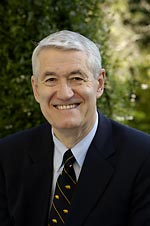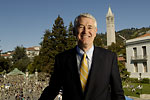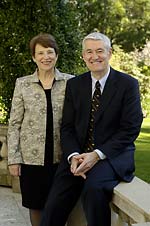 posted 11.24.2010 1 of 3 |
print-quality image: 300dpi,
205 Kb JPG
CAPTION: False color images of Jupiter and the SEB outbreak taken with the 8-meter Gemini North telescope in Hawaii on UT November 18, 2010. This false color composite is constructed from separate images at wavelengths of 2.12 microns (blue), 1.69 microns (yellow) and 4.68 microns (red), with an insert that enlarges the outbreak region. At 1.69 microns we see sunlight reflected from Jupiter’s main cloud deck – the same clouds we see in visible light. At 2.12 microns we see sunlight reflected from higher-altitude hazes above the main deck. At 4.68 microns we see thermal emission arising from the tops of Jupiter’s clouds, with the hottest emissions coming from the deepest atmosphere, and signifying regions with minimal overlying cloud cover. Note that the brightest areas at 1.69 and 2.12 microns signify regions of the outbreak where winds are lofting particles to high altitudes. In contrast, the dark regions around them (corresponding to visibly blue-gray areas) are clearings in the cloud deck. This is most clearly seen in the longitude-latitude map of the outbreak area shown in the insert. In the coming weeks, further outbreaks are expected to take place to the west (left) of those seen in this image, and the clear atmospheric regions will begin to fill this latitude band at the same time as the dark brown color typical of this region returns. Note that the size of the image at 4.68 microns was smaller than at the other two wavelengths and covered only that portion of the planet that included the outbreak. Credit: Glenn Orton, Padma Yanamandra-Fisher (Jet Propulsion Laboratory, California Institute of Technology), Leigh Fletcher (University of Oxford), Imke de Pater, Michael Wong (University of California, Berkeley), Chad Trujillo and Michelle Edwards (Gemini Observatory) and Christopher Go (University of San Carlos, Philippines) |
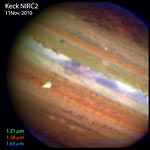 posted 11.24.2010 2 of 3 |
print-quality image: 300dpi, 208 Kb JPG
CAPTION: False color images of Jupiter and the SEB outbreak taken with the 10-meter W.M. Keck telescope in Hawaii on UT November 11, 2010, just 2 days after the initial discovery of the “outbreak”. This false color composite is constructed from images taken in narrow-band filters centered at 1.21 micron (green), 1.58 micron (red), and 1.65 micron (blue). At 1.21 and 1.58 micron we see sunlight reflected off Jupiter's upper cloud deck - the same clouds that are seen in visible light. The narrow band image at 1.65 micron shows sunlight reflected back from hazes just above these clouds. . The bright “spot” in the SEB is the outbreak where winds are lofting particles to high altitudes. Credit: James Graham (University of California, Berkeley and UofToronto/Dunlap Institute) Shelley Wright, Imke de Pater, Michael Wong (University of California, Berkeley). Christopher Go (University of San Carlos, Philippines) sharpened the images slightly using the RegiStax software, developed by Cor Berrevoets |
 posted 11.24.2010 3 of 3 |
print-quality image: 300dpi,
152 Kb JPG
CAPTION: False color images of Jupiter and the SEB outbreak taken with the 3-meter NASA Infrared Telescope Facility in Hawaii on UT November 16, 2010. This image is a false color composite at three wavelengths that probe diagnostic altitudes in Jupiter's atmosphere: 1.58 microns (blue) sensitive to sunlight reflected from Jupiter’s main cloud deck - also detected in visible light; 4.00 micron (green) detects sunlight reflected from higher-altitude particles well above the main deck; and 4.85 (red) micron detects the thermal emission arising from the tops of Jupiter’s clouds, with the hottest emissions coming from the deepest atmosphere, and signifying regions with minimal overlying cloud cover. The prominent region just to the left of the center, and expanded in the insert, shows the region of the South Equatorial Belt (SEB) outbreak. The initial outbreak is identified at the upper right, with a second outbreak to the lower left. Between them, in red, is a region of clear atmosphere, probably the result of downwelling from the easternmost plume. In the coming weeks, further outbreaks are expected to take place to the west (left) of those seen in this image. The clear atmospheric regions (in red) will begin to fill this latitude band at the same time as the dark brown color typical of this region returns. Credit: Glenn Orton, Padma Yanamandra-Fisher, Gregorio Villar (Jet Propulsion Laboratory, California Institute of Technology), David Griep (Institute for Astronomy, University of Hawaii), Leigh Fletcher (University of Oxford), Imke de Pater, and Michael Wong (UC Berkeley). |
 posted 9.12.2010 1 of 3 |
print-quality image: 300dpi,
2Mb JPG
Engineers make artificial skin out of nanowires CAPTION: An optical image of a fully fabricated e-skin device with nanowire active matrix circuitry. Each dark square represents a single pixel. Credit: Ali Javey and Kuniharu Takei, UC Berkeley |
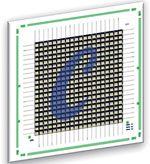 posted 9.12.2010 2 of 3 |
print-quality image: 300dpi,
988Kb JPG
CAPTION:Design layout of the artificial e-skin, using a mold in the shape of the Cal "C" to verify that the e-skin could correctly map its pressure profile. Credit: Ali Javey and Kuniharu Takei, UC Berkeley |
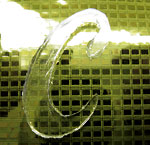 posted 9.12.2010 3 of 3 |
print-quality image: 300dpi,
1.3Mb JPG
CAPTION:Design layout of the artificial e-skin, using a mold in the shape of the Cal "C" to verify that the e-skin could correctly map its pressure profile. Credit: Ali Javey and Kuniharu Takei, UC Berkeley |
 posted 8.23.2010 1 of 2 |
print-quality image: 300dpi,
6.71 Mb JPG
Fall semester offers bounty of free arts programs CAPTION: Linda Tillery and the Cultural Heritage Choir perform at Cal Perfomances' Sept. 26 "Fall Free for All." Credit: Courtesy of Cal Performances |
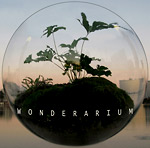 posted 8.23.2010 2 of 2 |
print-quality image: 300dpi,
228 Kb JPG
CAPTION: "Wonderarium," an acrylic floating terrarium will be launched on Oakland's Lake Merritt in 2012, and will be illuminated at night by solar-powered LED lights. UC Berkeley's Worth Ryder Gallery will display a terrarium prototype; Christopher Carmichael of the UC Botanical Garden is advising the artists on plant selection for the "punishing conditions" the terrarium will face on Lake Merritt. Credit: |
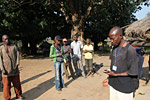 posted 8.3.2010 1 of 3 |
print-quality image: 300dpi, 9.8Mb JPG
Researchers document human toll of violence in Central African Republic CAPTION: Researchers adapted smartphones to help record interview responses in the Central African Republic, the first time such technology was used to conduct surveys in the country. Shown here are interviewers getting their PDA devices ready at the start of the day. Credit: Patrick Vinck |
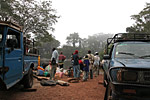 posted 8.3.2010 2 of 3 |
print-quality image: 300dpi, 8.4Mb JPG
CAPTION: Villagers wait along the shores of one of the many rivers in the Central African Republic that lack bridges or functioning barges. Crossing is only possible using pirogues. The bad shape of the road and transportation network in the country hinders trade and exchange. A survey by researchers at UC Berkeley’s Human Rights Center found a high rate of mortality, depression and anxiety in the country. Credit: Patrick Vinck |
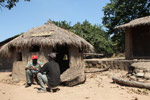 posted 8.3.2010 3 of 3 |
print-quality image: 300dpi, 11.4Mb JPG
CAPTION: Interviewers conducting surveys in the Central African Republic received thorough training before heading out into the field. Shown are workers conducting mock interviews in front of a Central African Republic home. During the actual survey, interviewers spent an hour or more with each respondent. Credit: Patrick Vinck |
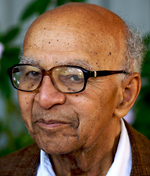 posted 7.14.2010 |
print-quality image: 300dpi,
2.7Mb JPG
Eminent statistician David Blackwell has died at 91 CAPTION: Statistician and mathematician David Blackwell joined the UC Berkeley faculty in 1954. He was the first tenured black professor in campus history and the first black admitted to the National Academy of Sciences. Credit: Photo courtesy of UC Berkeley Department of Statistics |
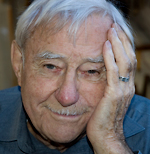 posted 5.12.2010 |
print-quality image: 300dpi,
2.5Mb JPG
Painter, printmaker Karl Kasten dies at age 94. CAPTION: Karl Kasten, professor emeritus of art practice, was a leading figure in "The Berkeley School" of abstract expressionism. Credit: UC Berkeley NewsCenter photo |
 posted 5.10.2010 |
print-quality image: 240dpi,
3.4 MB
Top graduating senior's life trajectory is amazing CAPTION: University Medalist Josh Biddle Credit: Wendy Edelstein/UC Berkeley |
 posted 4.27.2010 |
print-quality image: 300dpi,
11.9 MB
New orchid species is discovered in UC Botanical Garden collection CAPTION: A new orchid species — Ornithidium donaldeedodii, after orchidologist Donald Dod, a research associate at UC Berkeley — was discovered recently at the UC Botanical Garden. Credit: UC Botanical Garden |
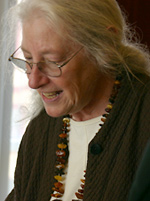 posted 4.20.2010 |
print-quality image: 300dpi,
320Kb JPG
Janet Adelman, scholar of Shakespeare, psychoanalytic and feminist critic, dies at 69 CAPTION: Janet Adelman, a UC Berkeley professor emeritus of English — who wove psychoanalysis, gender, and race into a scholarly exploration of Shakespeare and other English Renaissance authors — died on April 6, 2010, at 69. Credit: Brian Adelman |
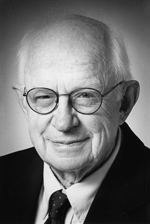 posted 3/05.2010 |
print-quality image: 300dpi,
232Kb JPG Thomas Pigford, influential voice in nuclear policy, dies at 87 CAPTION: Thomas Pigford, professor emeritus and founding chair of the Department of Nuclear Engineering at UC Berkeley, died Feb. 28, 2010 at the age of 87. Credit: Peg Skorpinski |
 posted 9/14.2009 1 of 2 |
print-quality image: 300dpi, 500Kb JPG Sierra Nevada birds move in response to warmer, wetter climate CAPTION: An adult male Western Bluebird, Sialia mexicana, a low elevation species, holding a large beetle. This bird species was found to have shifted its geographical range in response to both temperature and precipitation. Credit: Morgan Tingley |
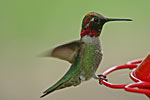 posted 9/14.2009 2 of 2 |
print-quality image: 300dpi, 1.1Mb JPG CAPTION: An adult male Anna's Hummingbird, Calypte anna, is an urban-adapted species. Unlike many other bird species in the Sierra Nevada mountains, the Anna's Hummingbird did not track its climatic niche. Instead, it moved away from it. Credit: Morgan Tingley |
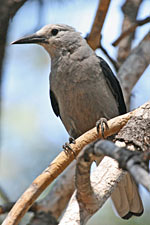 posted 9/14.2009 3 of 2 |
print-quality image: 300dpi, 660Kb JPG CAPTION: A high elevation species, the Clark's Nutcracker, or Nucifraga columbiana, responded to climate change by tracking temperature. Credit: Morgan Tingley |
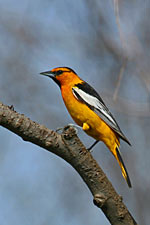 posted 9/14.2009 4 of 2 |
print-quality image: 300dpi, 250Kb JPG CAPTION: A low elevation species, the Bullock's Oriole, or Icterus bullockii, responded to climate change by tracking precipitation. Credit: Morgan Tingley |
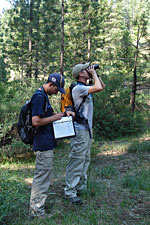 posted 9/14.2009 5 of 2 |
print-quality image: 300dpi, 1.1Mb JPG CAPTION: Pascal Title (left) and Morgan Tingley conduct a point count in the field. Credit: Allison Shultz |
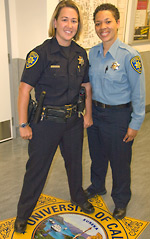 posted 8.29.2009 |
print-quality image: 300dpi,
4Mb JPG CAPTION: UCPD officer Ally Jacobs and police specialist Lisa Campbell Credit: Cathy Cockrell/UC Berkeley NewsCenter
|
| Chancellor Robert J. Birgeneau | |
|
|
print-quality image: 300dpi,
6.9Mb JPG Credit: John Blaustein photo |
|
|
print-quality image: 300dpi,
5.8Mb JPG Credit: John Blaustein photo |
|
|
print-quality image: 300dpi,
6.7Mb JPG Credit: John Blaustein photo |
|
|
print-quality image: 300dpi,
6.5Mb JPG Credit: John Blaustein photo |
Image Download Instructions
Mac: hold down mouse on image and choose "Save this image as". (Note: MS Internet Explorer browser may download the image to the desktop) |
|


